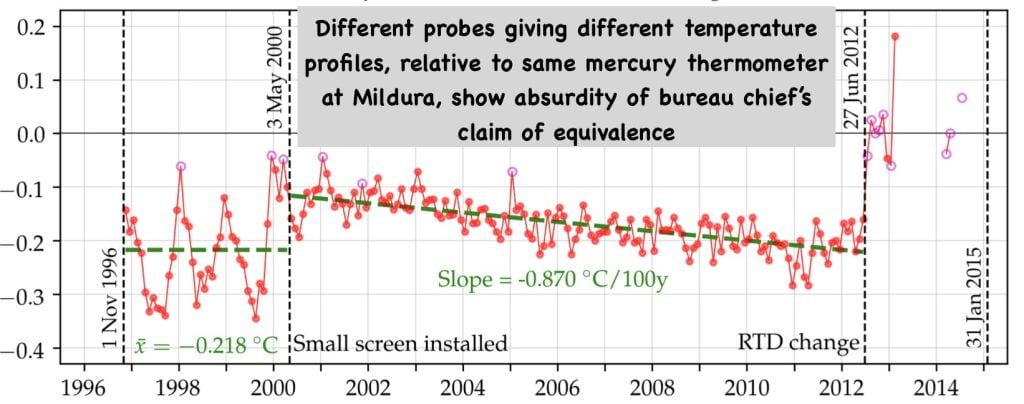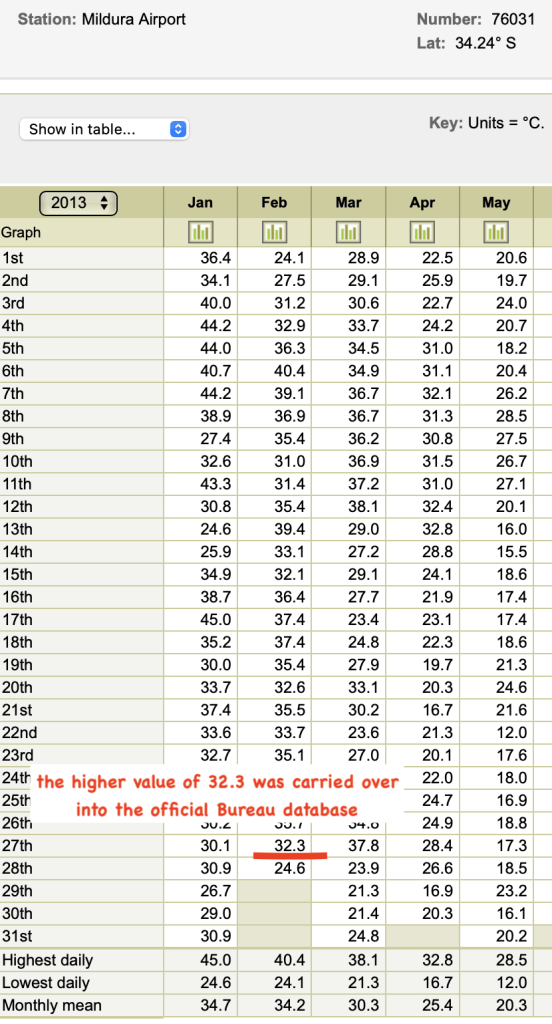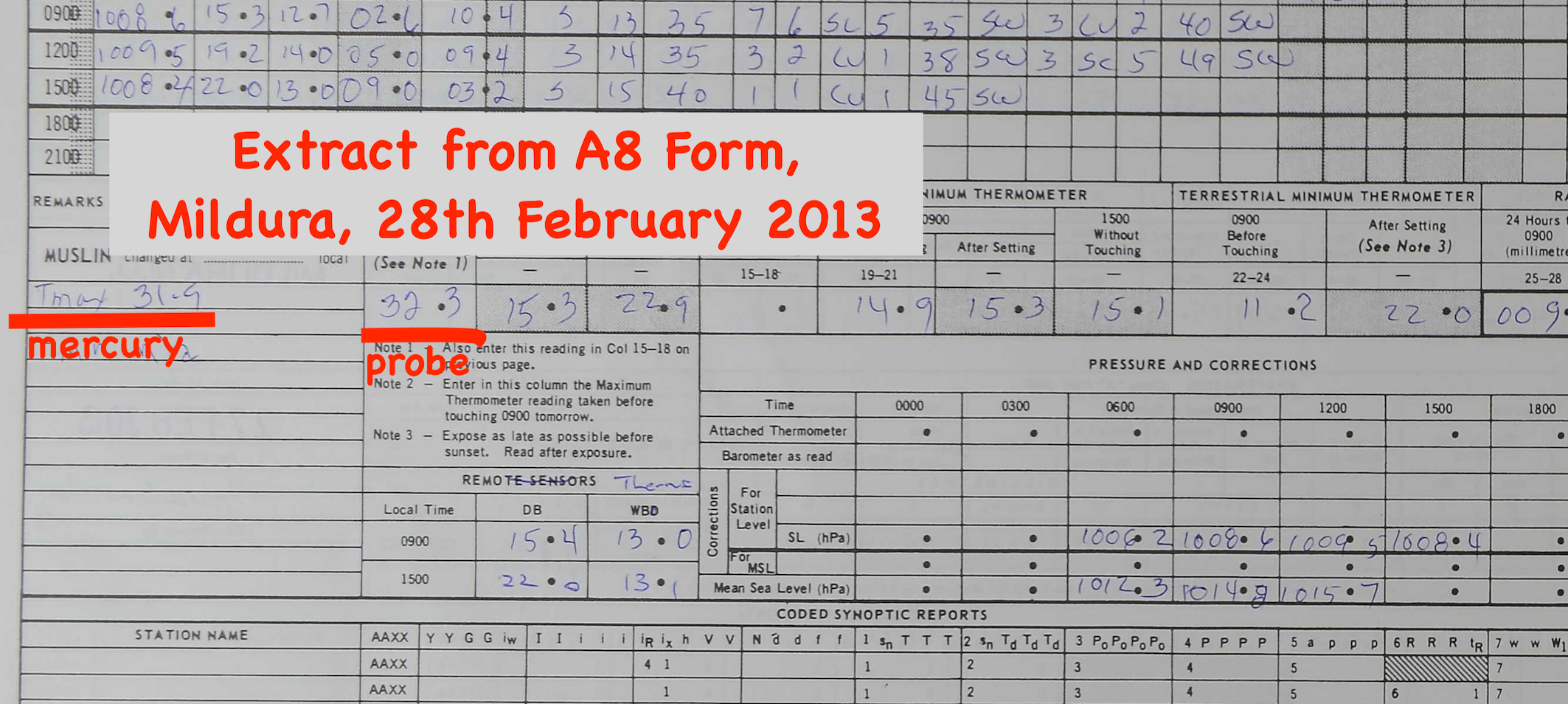Available Australian Bureau of Meteorology parallel maximum temperature data for Mildura – temperatures recorded from both a mercury thermometer and a platinum resistant probe on the same day in the same shelter – show no equivalence. They are different. Therefore, it is impossible to reliably compare official temperatures recorded from probes with historical temperatures recorded with mercury thermometers for the town of Mildura on the banks of the Murray River.
This has implications for claims of new record hot days for Mildura. If the issue of non-equivalence extends to all 700 automatic weather stations spread across the landmass of Australia, it was implications for the calculation of the global average temperature by NASA that relies on Bureau data. Indeed, if the instrument change has created a non-equivalence in the record, then no reliability can be placed on any claims by the Bureau and/or other scientists and institutions using Australian data, of record hot days, fewer extreme cold days or a claimed accelerated global warming trend.
I can’t know, because I was only able to secure the data for Mildura and this was following the intervention of then Minister for the Environment Josh Frydenberg back in October 2017. The intervention occurred after then popular 2GB radio broadcaster Alan Jones wrote to the Minister on my behalf asking that this data be made available to me.
It all began for me when on 23 September 2017, the Bureau reported a record hottest September day for the state of Victoria based on an instantaneous reading of 37.7 °C from its uncalibrated purpose-built temperature probe in a weather station at Mildura.
The media then repeated that this was the hottest September day ever recorded back to 1889.
Back in 1889, indeed for the period up until 1 November 1996, the Bureau used a properly calibrated mercury thermometer to measure official temperatures at Mildura.
I was sceptical of the instantaneous reading from the probe as representing a new record hot day. I set about getting access to the parallel data for Mildura that I hoped would allow me to see what the mercury thermometer in the same Stevenson screen had recorded on that day.
A Freedom of Information request, lodged by my husband John Abbot in December 2019, for parallel data for the other 34 official weather stations purported recording temperatures from mercury thermometers and probes in the same shelters has so far been denied by the Bureau.
Boris Kelly-Gerreyn from the Bureau initially claimed provision of the scanned A8 forms too onerous and of no public interest. More recently, and as preposterously, Boris Kelly-Gerreyn has claimed the information does not exist in the form of reports and therefore cannot be provided. On 29th November 2021, Elizabeth Hampton, Acting Freedom of Information Commissioner, absurdly sided with the Bureau. John Abbot lodged a complaint with the Administrative Appeals Tribunal that will be heard on 3rd February in Brisbane.
I received scans of the A8 Forms from Mildura at the direction of Minister Frydenberg as two tranches in October and then December 2017.
My immediate and initial analysis of the first tranche indicated that the probe was recording too cool relative to the mercury. I wrote to the Minister asking for more A8Forms and recommending that the Bureau:
1. Suspend the announcement of new record hot days;
2. Inform the World Meteorological Organisation that its temperature measurements from probes are not comparable with historical measurements from mercury thermometers;
3. Establish an audit mechanism.
I was ignored by the Minister. Australian science writer and blogger Joanne Nova did publish something at her blog. It was most disheartening when Bill Johnston in the same thread set about discrediting my findings.
After receiving the second tranche, and tediously manually transcribing more mercury and probe values from the scanned A8 Forms from Mildura, my second go at analysis again confirmed that the first probe – recording official temperatures from 1 November 1996 until 3 May 2000 – erroneous recorded temperatures too cool by 0.2 °C, and with a strong seasonal variation. The difference is statistically significant.
On 3 May 2000, the Bureau changed the Stevenson screen to a smaller design, and while there is no record of a change in the type of probe, this almost certainly also occurred based on the very different recording pattern relative to the mercury that I found through analysis of the data after transcribing the values from the scanned A8 Forms.
Initially the temperatures as recorded at Mildura, from what I am assuming was a new second probe in the new shelter, where more consistent with the measurements from the mercury thermometer. But then I could see from the data that the temperatures from the probe started to cool relative to the mercury thermometer for the period to 27 June 2012. Cooling was at a rate of nearly 1°C per 100 years.
Then on 27 June 2012 the probe which had now been recording the official temperature at Mildura for 12 years while drifting to record ever cooler, was changed.
The limited available parallel data indicates that this third probe records too hot relative to the same mercury thermometer – often by 0.4 °C.

After the 27 June 2012, the Bureau stopped recording parallel data every day, particularly on hotter days. To be clear, on the hottest days from the period 27 June 2012 through until 31 January 2015 there are no recordings from the mercury thermometer and so this data is not normally distributed. I explained all of this in a blog post on 11 February 2018, that again received surprising little attention.
I notified mainstream climate scientists and various journalists but they didn’t seem to want to understand what it all meant. I had been concerned about the issue since 2014, when I wrote to Australia’s Chief Scientist, Alan Finkel. Now I felt I had some more and compelling proof. I was concerned that the entire historical temperature record for Australia was becoming compromised, and I lost interest in my weather forecasting using machine learning so dependent on reliable temperature data.
Meanwhile, these same university professors who showed no interest in any of the quality assurance issues associated with the change in instrumentation that I was alerting them to by email, claimed that it had suddenly got a lot hotter here in Australia.
Sophie C. Lewis and Andrew D. King, for example, publishing in Geophysical Research Letters (volume 42, Issue 18) conclude that it has gotten significantly hotter here in Australia since 2012. They attribute the ‘dramatically increased rate of observed hot record breaking in recent Australian temperatures’ to human-caused global warming.
I wrote to Dr Lewis suggesting the step-up in temperatures could be because of changes in how temperatures are measured, specifically a change over to a third probe design. She never replied.
The World Meteorological Organisation provides a definition of daily maximum temperature: the highest temperature in that 24-hour period that can be read directly from a mercury thermometer, but when using a temperature probe ‘instantaneous’ values must be averaged over one to ten minutes.
Ignoring all of this, the Australian Bureau of Meteorology uses purpose-built probes and takes instantaneous readings. These are then used uncritically to claim catastrophic human-caused global warming – and record new hot days, including at Mildura.
I predict that this is going to all come crashing down one day, including on the careers of Sophie Lewis, Andrew King, Boris Kelly-Gerreyn and Elizabeth Hampton.
It could have started to be put right by Josh Frydenberg back in 2017, but he obfuscated. Much thanks to Alan Jones for at least trying to get something done.
There is still time for the current director of the Bureau, Andrew Johnston, to help me work out the extent of the problem by making all the parallel data public. But so far, he won’t even met with me; all-the-while emailing that the bureau’s purpose designed probes are equivalent to the old mercury thermometers making numerical averaging unnecessary. Except the limited data that I have obtained, transcribed and analysed for Mildura tells a completely different story. A story of incompetence, as much as malfeasance.



 Jennifer Marohasy BSc PhD is a critical thinker with expertise in the scientific method.
Jennifer Marohasy BSc PhD is a critical thinker with expertise in the scientific method.

Hmm…. for decades the biggest recruitment areas in government and associated agencies were “climate” science and GW. At universities too, the magic funding formula for research funding was “climate” &/or GW. These filters have built a vast infrastructure dependent on hiding the facts.
Keep up the good work and the pressure on BOM. The Global Warming/climate change industry needs to be called out.
The temperature recording systems chosen by the BOM are based on the system which will provide the greatest upward error in recorded data to conform with the political desire to create a climate warming scenario irrespective of the true temperatures that actually occur. This is corruption on a grand scale and every effort must be made to prosecute those responsible. It should not be forgotten that $millions are being made on the back of this corruption by unscrupulous investors in the so-called green economy.
I wrote an essay using the tempertature time series for 10 cities in the US from when first reccorded to 2000. The annual averages showed the realistic trend that has been used by alarmists like the UN IPCC and modellers of global warming. It’s true there has been an increase since 1883, Krakatoa.
However the modern ‘alarming’ temperature was achieved in the 1850-70 range after the Little Ice Age. Then a ‘rage’ of volcanic eruptions from 1875-1932 kept a lid on the regression toward the mean.
Individual temperatures are ‘regionalised variables”. I have five thermometers scattered outside my home in Toronto, Canada and they differ greatly unless there is a brisk wind. NOAA has since rigged all those time series to obscure the rapid regression to the mean after the LIA.
Interestingly, NASA’s current estimate for global temperature, for what it’s worth, was estimated by Arrhenius in his second paper in 1906 from his CO2 data at the time. It has not changed.
https://www.dropbox.com/s/jkh4yqxleiuqtu8/Volcanoes%2C%20ENSO%20and%20Carbon%20Dioxide.pdf?dl=0
More pressure needs to be applied to the BOM. Perhaps a petition highlighting the recent uptick in Humpback deaths in the vicinity of the Offshore Wind Industry which is being driven by the increasing temperature record which we all know has been doctored.
Much thanks to Charles for republishing, https://wattsupwiththat.com/2023/01/24/hyping-maximum-daily-temperatures-part-2/
Hello Jennifer,
I have a couple of questions, if you don’t mind:
1 In what sense is the “is the higher instantaneous value of 32.3C recorded by the uncalibrated purpose-designed probe that has been recorded in the official database” uncalibrated?
2 You mention WMO numerical averaging. I don’t know what forms of temperature recording are used around the world … but I’ve seen (for example) that the highest ever summer (i.e. July) temperatures ever recorded in England/U.K. occurred in 2022. Are international weather bodies such as the U.K. using these new instantaneous electronic sensors, as is BOM?
I accept that it is relevant to consider the method of registering a temperature within a framework of time. I have thought for quite some time that you objected to instantaneous readings per se. Now I’m unsure … perhaps your point is to do with calibration rather than with time-frames?
What should we do with the longer time frames that seemed to have been a necessary part of the collation of data taken from the ‘old’ mercury/alcohol thermometers? Do we view their maxima as ‘truth written in stone’? Do we view BOM’s ‘reinterpretations’ of such records as legitimate endeavours or as ‘deep state’ attempts to subvert the truth. Can we not now say that instantaneous registers are an improved method of recording the highest temperature recorded on a particular day … at a particular moment?
If previous thermometer methods could not/did not record momentary peaks, does that mean we have to stick with them forever … or is it just that the new methods are not properly ‘calibrated’?
I read what you post Jennifer, but I usually find myself standing on the other side of the climate-change fence. But I continue to read your posts because your act as a scientist and you use documents, videos etc to support your views.
Thank you,
Garry Stannus.
On my recommended reading list for today
https://honestclimatescience.blogspot.com/2023/01/the-best-climate-science-and-energy.html
Thanks Garry,
Instruments are calibrated so they measure according to a known standard and within a given range. Calibration makes them accurate and reliable.
This is particularly important if there is a change in the type of instrumentation. So with the change from mercury thermometers that have long time constants (i.e. take perhaps 40 seconds to adjust to a change in air temperature) to platinum resistant probes we want to know that what is defined as the maximum daily temperature is equivalent.
The World Meteorological Organisation provides a definition of daily maximum temperature: the highest temperature in that 24-hour period that can be read directly from a mercury thermometer, but when using a temperature probe ‘instantaneous’ values must be averaged over one to ten minutes.
Ignoring all of this, the Australian Bureau of Meteorology uses purpose-built probes and takes instantaneous readings. The highest spot reading is then recorded as the maximum temperature for that day.
The probes are uncalibrated in that I can see from the parallel records for Mildura (specifically the temperatures as recorded for 28th February 2013) that they are recording over an unacceptably wide range relative to the mercury thermometer. The probe has recorded 0.4 degrees Celsius warmer. This is outside the range of acceptable difference of within plus or minus 0.2.
I hope this helps. I could write a lot more.